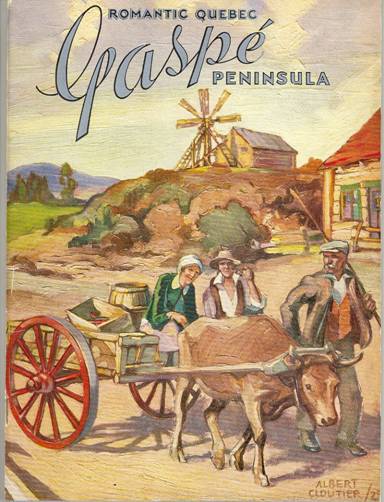
|
|
| Date Published: |
L’Encyclopédie de l’histoire du Québec / The Quebec History Encyclopedia
Gaspé
Gaspé scene from a painting of Albert Cloutier This painting exemplifies the romantic view of the Gaspé that prevailed in the 1930's. Source: from a brochure of the Provincial Tourist Bureau in association with the Roads Department, Quebec, c. 1935, 32p. Gaspé, a county in Quebec, at the eastern end of the Gaspé peninsula. For provincial purposes the county is divided into Gaspé-nord and Gaspé-sud. The chief town is Percé. Pop. 55,208 [in 1948].
Gaspé, a village in Gaspé county, Quebec, on the south shore of Gaspé basin. Its population, half Roman Catholic, half Protestant [in 1948; the population is heavily Roman Catholic now as most anglophones have left the Gaspé region for other parts of the province or the country.]
Gaspé bay lies on the south-east coast of the Gaspé peninsula, between cape Gaspé and Whale head. It has a depth of 16 miles and an average width of 5 miles, and is one of the most commodious harbours on the Atlantic seaboard. From its extremity two inlets, known as the north-west and south-west arms, penetrate some distance into the interior, and receive the waters of several rivers.
Gaspé, cape, the promontory at the north of the entrance to Gaspé bay, at the north-eastern end of the Gaspé peninsula. It is the eastern extremity of the Shickshock mountains, and resembles "a fantastic ship, the poop of which rises to a height of 1,500 feet, and the prow of which towers 365 feet above the ocean". It is called by the English also Ship head.
Gaspé peninsula, an immense tongue of land in the province of Quebec, lying between the St. Lawrence river and gulf and the bay of Chaleur . It is about 150 miles long, and has a coastline, from Cap Chat on the north to Restigouche on the south, of about 375 miles. The interior of the peninsula is mountainous, the Shickshock mountains providing for it a sort of backbone. The chief industries of the peninsula are fishing and lumbering; but it is becoming more and more of a tourist resort, since the construction of a motor highway around the coast. It comprises two counties of Quebec, Gaspé and Bonaventure, which have a combined population (1931) of 66,619. Since an early period, the name "Gaspesia" has been applied to the peninsula; but this term appears to have been confined exclusively to literary usage. The literature relating to the peninsula has been voluminous; but especial mention should be made of C. Leclercq, New relation of Gaspesia, tr. and ed. by W. P. Ganong (Toronto, Champlain Society, 1910), J. B. Perland, La Gaspésie (Quebec, 1877), J. C. Langelier, Esquisse sur la Gaspésie (Lévis, 1884; new ed., Quebec, 1885), A. Béchard, La Gaspésie en 1888 (Quebec, 1918), J. M. Clarke, Sketches of Gaspé (Albany, 1908) and The heart of Gaspé (New York, 1913), A. Pelland, La Gaspésie (Quebec, 1914), Rev. A. Bernard, La Gaspésie en soleil (Montreal, 1925), and C. E. Roy and L. Brault, Gaspé depuis Cartier (Quebec, 1934). Source : W. Stewart WALLACE, ed., The Encyclopedia of Canada, Vol. III, Toronto, University Associates of Canada, 1948, 396p., pp. 11-12.
|
© 2005
Claude Bélanger, Marianopolis College |
|
